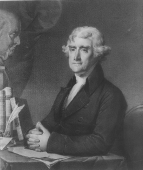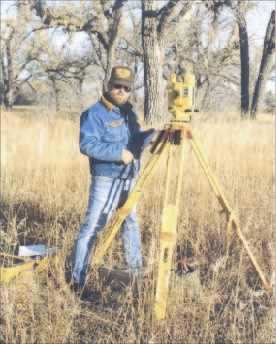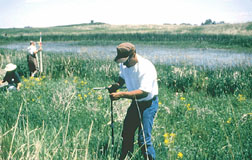Thomas Jefferson
U.S. Geological Survey hydrologic technician running levels for bridge scour on the Cannonball River near Breien, ND.
The U.S. Geological Survey gathers information and conducts studies on water resources in North Dakota. Above, a U.S. Geological Survey employee is conducting a study of the prairie wetlands of North Dakota. |
President Thomas Jefferson’s Instructions to Captain Meriwether LewisExcerpts… The object of your mission is to explore the Missouri river, & such principal stream of it, as, by it’s course & communication with the waters of the Pacific Ocean, may offer the most direct & practicable water communication across this continent, for the purposes of commerce. Beginning at the mouth of the Missouri, you will take observations of latitude & longitude, at all remarkable points on the river, & especially at the mouths of rivers, at rapids, at islands & other places & objects distinguished by such natural marks & characters of a durable kind, as that they may with certainty be recognized hereafter. the courses of the river between these points of observation may be supplied by the compass, the log–line & by time, corrected by the observations themselves. the variations of the compass too, in different places, should be noticed. … Your observations are to be taken with great pains & accuracy, to be entered distinctly, & intelligibly for others as well as yourself, to comprehend all the elements necessary…. … Other objects worthy of notice will be the soil & face of the country, it’s growth & vegetable productions; especially those not of the U. S. the animals of the country generally, & especially those not known in the U. S. the remains and accounts of any which may deemed rare or extinct; the mineral productions of every kind; but more particularly metals, limestone, pit coal & salpetre; salines & mineral waters, noting the temperature of the last, & such circumstances as may indicate their character. Volcanic appearances. climate as characterized by the thermometer, by the proportion of rainy, cloudy & clear days, by lightening, hail, snow, ice, by the access & recess of frost, by the winds prevailing at different seasons, the dates at which particular plants put forth or lose their flowers, or leaf, times of appearance of particular birds, reptiles or insects. … Given under my hand at the city of Washington, this 20th day of June 1803. Th. Jefferson |
The Mission of the U.S. Geological SurveyThe USGS serves the Nation by providing reliable scientific information to:
Our mission is very similar to that of Lewis and Clark and the Corps of Discovery. We participate in many projects that are continuations of those begun by Lewis and Clark, such as:
|



